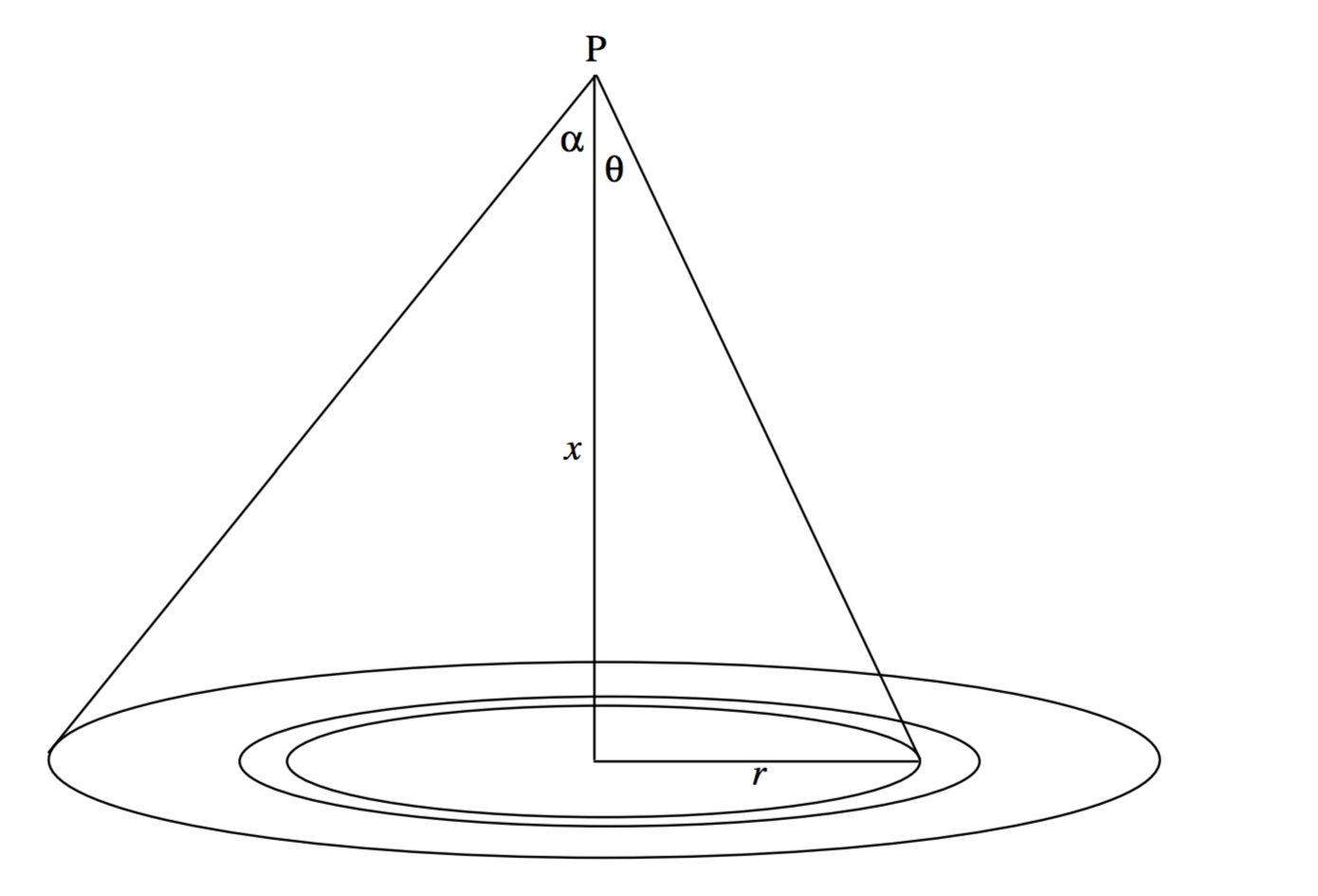1.6E: Field on the Axis of a Uniformly Charged Disc
- Page ID
- 6476
\( \newcommand{\vecs}[1]{\overset { \scriptstyle \rightharpoonup} {\mathbf{#1}} } \)
\( \newcommand{\vecd}[1]{\overset{-\!-\!\rightharpoonup}{\vphantom{a}\smash {#1}}} \)
\( \newcommand{\id}{\mathrm{id}}\) \( \newcommand{\Span}{\mathrm{span}}\)
( \newcommand{\kernel}{\mathrm{null}\,}\) \( \newcommand{\range}{\mathrm{range}\,}\)
\( \newcommand{\RealPart}{\mathrm{Re}}\) \( \newcommand{\ImaginaryPart}{\mathrm{Im}}\)
\( \newcommand{\Argument}{\mathrm{Arg}}\) \( \newcommand{\norm}[1]{\| #1 \|}\)
\( \newcommand{\inner}[2]{\langle #1, #2 \rangle}\)
\( \newcommand{\Span}{\mathrm{span}}\)
\( \newcommand{\id}{\mathrm{id}}\)
\( \newcommand{\Span}{\mathrm{span}}\)
\( \newcommand{\kernel}{\mathrm{null}\,}\)
\( \newcommand{\range}{\mathrm{range}\,}\)
\( \newcommand{\RealPart}{\mathrm{Re}}\)
\( \newcommand{\ImaginaryPart}{\mathrm{Im}}\)
\( \newcommand{\Argument}{\mathrm{Arg}}\)
\( \newcommand{\norm}[1]{\| #1 \|}\)
\( \newcommand{\inner}[2]{\langle #1, #2 \rangle}\)
\( \newcommand{\Span}{\mathrm{span}}\) \( \newcommand{\AA}{\unicode[.8,0]{x212B}}\)
\( \newcommand{\vectorA}[1]{\vec{#1}} % arrow\)
\( \newcommand{\vectorAt}[1]{\vec{\text{#1}}} % arrow\)
\( \newcommand{\vectorB}[1]{\overset { \scriptstyle \rightharpoonup} {\mathbf{#1}} } \)
\( \newcommand{\vectorC}[1]{\textbf{#1}} \)
\( \newcommand{\vectorD}[1]{\overrightarrow{#1}} \)
\( \newcommand{\vectorDt}[1]{\overrightarrow{\text{#1}}} \)
\( \newcommand{\vectE}[1]{\overset{-\!-\!\rightharpoonup}{\vphantom{a}\smash{\mathbf {#1}}}} \)
\( \newcommand{\vecs}[1]{\overset { \scriptstyle \rightharpoonup} {\mathbf{#1}} } \)
\( \newcommand{\vecd}[1]{\overset{-\!-\!\rightharpoonup}{\vphantom{a}\smash {#1}}} \)

\(\text{FIGURE I.3}\)
We suppose that we have a circular disc of radius a bearing a surface charge density of \(σ\) coulombs per square metre, so that the total charge is \(Q = πa^2 σ\). We wish to calculate the field strength at a point P on the axis of the disc, at a distance \(x\) from the centre of the disc.
Consider an elemental annulus of the disc, of radii \(r\) and \(r + δr\). Its area is \(2πrδr\) and so it carries a charge \(2πσrδr\). Using the result of subsection 1.6.4, we see that the field at P from this charge is
\[\frac{2\pi\sigma r \,\delta r}{4\pi\epsilon_0}\cdot \frac{x}{(r^2+x^2)^{3/2}}=\frac{\sigma x}{2\epsilon_0}\cdot \frac{r\,\delta r}{(r^2+x^2)^{3/2}}.\]
But \(r=x\tan \theta,\, \delta r=x\sec^2 \theta \delta \theta \text{ and }(r^2+x^2)^{1/2}=x\sec \theta\). Thus the field from the elemental annulus can be written
\[\frac{\sigma}{2\epsilon_0}\sin \theta \,\delta \theta .\]
The field from the entire disc is found by integrating this from \(θ = 0 \text{ to }θ = α\) to obtain
\[E=\frac{\sigma}{2\epsilon_0}(1-\cos α )=\frac{\sigma}{2\epsilon_0}\left ( 1-\frac{x}{(a^2+x^2)^{1/2}}\right ).\tag{1.6.11}\]
This falls off monotonically from \(σ/(2\epsilon_0)\) just above the disc to zero at infinity.


